-
Paper Information
- Paper Submission
-
Journal Information
- About This Journal
- Editorial Board
- Current Issue
- Archive
- Author Guidelines
- Contact Us
American Journal of Sociological Research
p-ISSN: 2166-5443 e-ISSN: 2166-5451
2021; 11(1): 1-6
doi:10.5923/j.sociology.20211101.01
Received: Jul. 29, 2021; Accepted: Aug. 8, 2021; Published: Aug. 15, 2021

Women and COVID-19: Exploration of the Impact on Psychological Health, Nutritional and Hygiene Practices
Alfred J. Lawrence1, Umama Fatima1, Faiza Ali1, Saima Arif1, Ancey Abraham1, Samridhi Dwivedi1, Tahmeena Khan2
1Department of Chemistry, Isabella Thoburn College, Lucknow, India
2Department of Chemistry, Integral University, Lucknow, India
Correspondence to: Tahmeena Khan, Department of Chemistry, Integral University, Lucknow, India.
| Email: |  |
Copyright © 2021 The Author(s). Published by Scientific & Academic Publishing.
This work is licensed under the Creative Commons Attribution International License (CC BY).
http://creativecommons.org/licenses/by/4.0/

The impact of the crisis is never gender-neutral and COVID-19 is no exception. While everyone is facing unprecedented challenges, women are bearing the brunt of economic and social fallout of COVID-19. Mental health, hygiene and nutritional aspects are very important for the assessment of the well-being of a person. This paper has shed light on the impact of COVID-19 pandemic on women associated impact on their lives in the current scenario. Through an online questionnaire survey with 510 women of different age groups and strata of the society, the impact of the pandemic has been assessed especially in Indian context.
Keywords: Women, Survey, COVID-19, Health
Cite this paper: Alfred J. Lawrence, Umama Fatima, Faiza Ali, Saima Arif, Ancey Abraham, Samridhi Dwivedi, Tahmeena Khan, Women and COVID-19: Exploration of the Impact on Psychological Health, Nutritional and Hygiene Practices, American Journal of Sociological Research, Vol. 11 No. 1, 2021, pp. 1-6. doi: 10.5923/j.sociology.20211101.01.
Article Outline
1. Introduction
- End of the year 2019 marked the recognition of a new viral disease and the beginning of 2020 witnessed the rapid increase in the COVID-19. The world is struggling to deal with the pandemic and varying levels of preventive measures have been taken to reduce the devastating effects of the virus leading to nationwide lockdown. Subsequently, people have been staying at home and maintaining physical distancing. These measures have also resulted in closure of schools, colleges, offices, workplaces and other non essential services [1]. Pandemics like the current COVID-19 outbreak, are tough situations which affect the society at multiple levels. Though right now the entire human race is in grave danger owing to the untamed spread of the disease across the continents, somewhere the societal effects of the such situation are somewhat discriminated and gender biased and usually the marginalized population and women of the society are more at the receiving end. As the pandemic continues, so does the disparities in disease risk and outcomes for vulnerable members of the society. The COVID-19 pandemic has had a major impact on the "care economy", making women more likely to bear the brunt of the social and economic consequences of the pandemic [2]. According to the World Health Organization (WHO), women constitute 70 percent of the health workforce and are more likely to be front-line health workers, especially nurses, midwives and community health workers [2]. Gender is a social determinant of health [3], as women on an average have reported more unhealthy days mentally and physically per year than men [4]. Studies have already reported the differential effect of the pandemic on the health and psychological well-being and established a strong relationship between being a woman and loneliness during the COVID-19 crisis and signs of anxiety and depression [5-6]. Spiritual well-being is another factor where women have shown the lowest level of overall well-being [5]. Women have also faced prevalent health conditions like asthma, diabetes and myocardial infarctions [7]. These health conditions are frequently encountered by women belonging to low socioeconomic class, lower educational background, rural set ups, older age or due to some physical disability or LGBTQIA identity [8]. Nutritional aspects are also an important factor to explore because the pandemic cornered women from accessing basic health facilities & nutritional services. The general nutritional conditioning of women in India is not very appreciable. According to a report, in India 53% of adolescent girls are anaemic, 80% are thin or obese, 31% suffer from vitamin B12 deficiency and 37% suffer from folate deficiency [9]. The pandemic imposed restrictions on such undernourished women risking their lives at a higher level. Considering women in India, diets are often too poor to meet their nutritional needs. As a consequence, most women in India are undernourished in their reproductive age having body mass index (BMI) of less than 18.5 kg/m [10]. The aftermath of poor health & improper diet have many repercussions triggering an intergenerational cycle of under-nutrition as women with poor health are less likely to have healthy babies. The undernourished babies might suffer from problems like cognitive impairments, scurvy, rickets or neonatal hypocalcemia (infants born with low calcium levels). Lack of education, difficulty in accessing basic health & nutrition services, deterioration in the quality of food consumed and retrogression in the surrounding hygiene, etc can be improbable reasons for the poor health of women. The worse situation of the nutritional status of women has only deteriorated further due to COVID-19 pandemic. This study was undertaken as an online survey with 510 women respondents belonging to different age groups, economic and educational backgrounds to know how their overall mental and nutritional health and hygiene practices and how they were impacted by the COVID-19 pandemic.
2. Material and Methods
- To assess the impact of the pandemic on women at different levels an online survey was conducted with women belonging to different strata and age groups. The study was conducted for a period of one month from 15th November-15th December, 2020. The questionnaire was compiled under the guidance of medical doctors and experts. The questionnaire survey done in this study was in accordance with the Rapid Gender Assessment Surveys on the Impact of COVID-19 Guidance documents, developed by the United Nation’s Women’s global gender data programme, Making Every Woman and Girl Count (Women Count) in response to the COVID-19 pandemic (https://data.unwomen.org/publications/guidance-rapid-gender-assessment-surveys-impacts-covid19). The survey was posted as Google form on different social media platforms and shared publicly to facilitate snowball sampling. Clear instructions were given in the form to the participants related to the purpose of the study and it was agreed that their personal details would be kept confidential. Questions pertaining to the changes and symptoms related to psychological impact, changes in physical activity pattern, nutritional and hygiene practices were included in the questionnaire. The survey took into account of pre-pandemic and current scenario to assess the changes in life style. Owing to the non-mandatory nature of the questions, the numbers of responses varied in different sections. The percentage was calculated according to the number of responses obtained for each question. The questionnaire is given as Supplementary Figures (1-4).
3. Results and Discussion
3.1. Activity Pattern and Changes
- Of all the participants, majority of them belonged to the age group 20-29 years (47.6%) and 15-19 years (38.6%). 99.6% of the total participants were Indian residents however, remaining 0.4% belonged to United Arab Emirates and Kingdom of Saudi Arabia. 79 out of the 510 women were married and rest were single. 87.6% of them belonged to urban area of residence, 63.1% living in single nuclear families with maximum 1-5 family members. Majority of the women respondents had university degree out of which 33.5% were graduates and 30% were post-graduates (Figure 1). 76.5% of the total participants were students while 16.7% were f working professionals. As per the survey results, 13 women reported pregnancy while 6 suffered from abortion or miscarriage during the lockdown period. Talking about the safe abortions and usage of contraception, according to a maternity centre, approximately 9.5 million women are less likely to visit the centre, mainly due to their fear to catch the infection and as measure to control COVID-19. As a result of this, in future births of malnourished children are predicted because of the hindrance in visits [11]. The Foundation for Reproductive Health Services, India has estimated that due to the lockdown. 26 million couples in India were unable to access contraception, leading to 2.3 million unwanted pregnancies and over 8000000 unsafe abortions which is the third leading cause of maternal deaths in India [12]. The “stay at home” time has facilitated people to catch up with self-indulgence and looking after their health and hygiene. The isolation phase during the pandemic gave women a chance to pay attention to their health and indulge in healthy living. 69.4% women reported to spend time on physical fitness (Figure 2); however majority of them (49.7%) devoted less than 30 minutes on physical activity, whereas 40.9% of the respondents devoted one hour for maintaining their physical fitness. Gyms being shut, 31.9% women adopted yoga for physical fitness while 37.7% indulged in various other activities like walking, dancing, and aerobics etc. (Figure 3). Different factors govern how much leisurely time is spent by women, of which marital status is of prime importance. It has been found that unmarried women have more time for themselves than married ones [13]. Overall leisure time is usually a sum of active time (spent on exercising or devoted to physical activity) or passive time (spent on watching TV or surfing the internet or grocery shopping) [14]. As the pandemic continues, it would be crucial to know whether physical activity or exercise might interact with the immune system. Retrospective studies are needed to see whether physical activity status has any association with the COVID-19 infection. Leading by the current practical advice, people should follow a health regimen daily as reduced physical fitness may increase vulnerability towards infection.
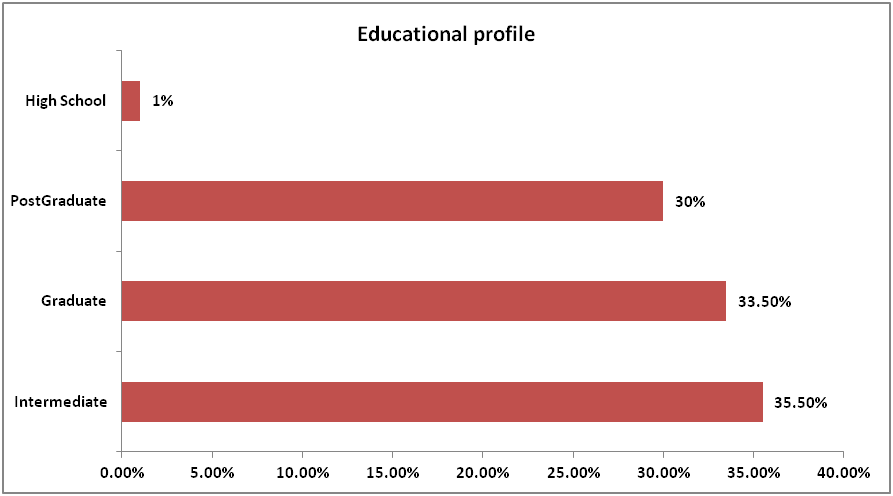 | Figure 1. Educational Profile of participants |
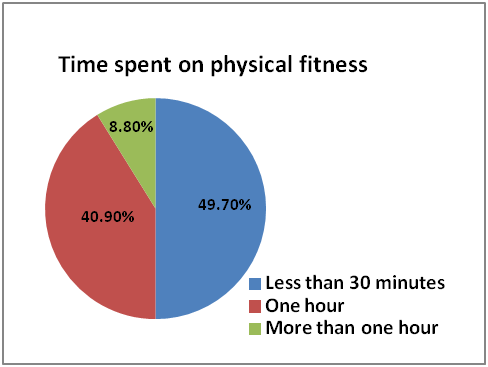 | Figure 2. Time spent on physical fitness during lockdown |
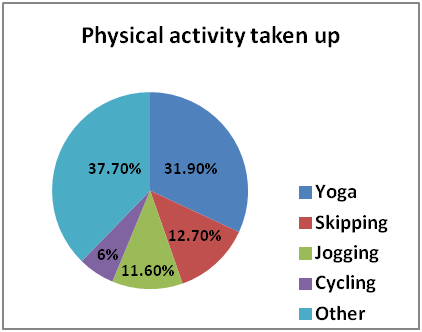 | Figure 3. Physical activity taken up |
3.2. Psychological Impact and Symptoms
- Physical and mental health has been hampered with a disproportionate impact on women during the pandemic. Moderate to severe psychological impact of the pandemic calls for urgent medical intervention [9]. Due to lack of access to diagnostic facility and pharmacological treatment, this may lead to poor mental health. Mental health disorders are faced by women more during the past pandemics as well owing to social isolation, extra household burden and resource insecurity. A multinational survey had indicated that women without social support are more prone to experience adverse mental health outcomes than their male counterparts without social connections, as women rely more on social support and acceptance [16]. Lack of concentration (n=243), arguments with family members (n=243), anxiety (n=232), anxiety (n=232), weight gain (n=253), and sadness (n=53) were some of the most common symptoms reported by the participants (Figure 4). Since majority of the participants were college going students, they also cited academic loss (n=253) as a major issue faced during the pandemic and subsequent lockdown. Majority (n=249) of the respondents shared their worries with their mothers, followed by their friends (n=236) (Figure 5). 226 respondents also told to have missed visit to doctors and medical assistance. The probable limitation of the results may be that the depressive and anxiety symptoms were self-reported. As experienced from the past pandemics, the stressful impact of the infectious disease involves many factors including 1. Practising social distancing, to control the spread of disease, and 2. Avoiding those who have been potentially exposed or infected [17]. Stress and tension may influence the menstrual cycle of a woman. The menstrual cycle is controlled by the hypothalamic-pituitary-ovarian (HPO) axis by positive and negative feedback mechanisms between the hypothalamus, anterior pituitary, and ovaries. The HPO may be affected by common stressors including insufficient fuelling strategies, psychological stressors, or significant alterations to physical stress, travel, and inadequate sleep [18]. 28.8 per cent (n= 140) women reported that their menstrual cycle has been affected in the pandemic and 20.4 per cent (n= 74) women reported having a shortening in their cycle. These findings are important from the point of view that women in India usually shy away from discussing their menstrual health and anonymously they felt free to disclose the changes they have observed in their menstrual health.
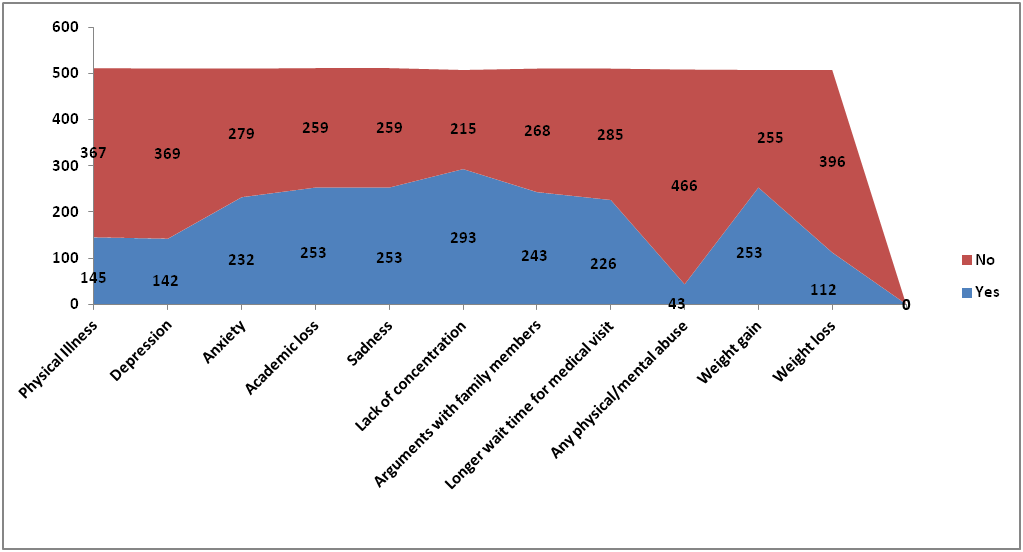 | Figure 4. Common symptoms reported by the respondents during the lockdown |
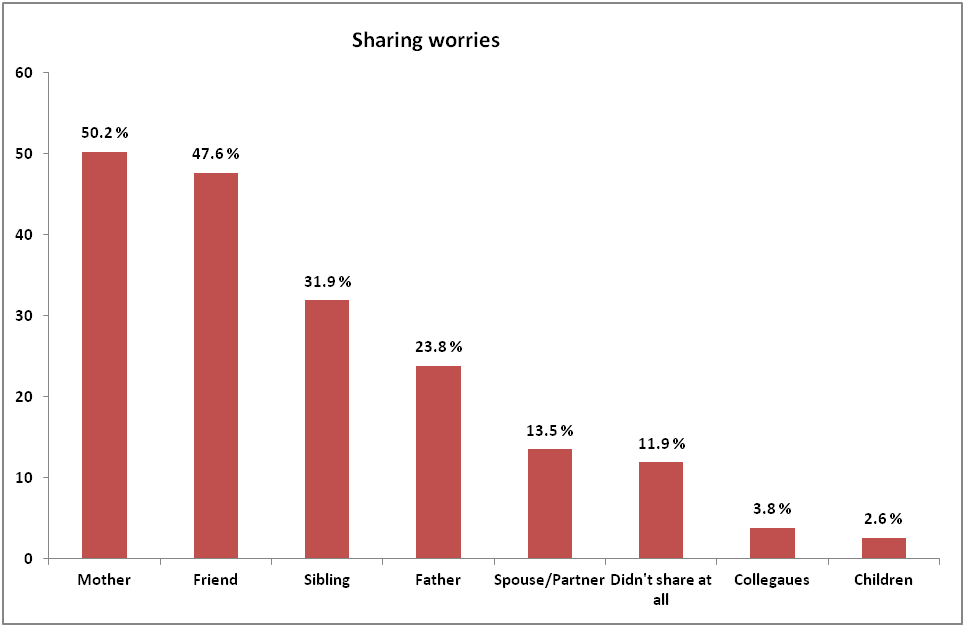 | Figure 5. Sharing worries |
3.3. Effect on Nutritional Health
- To maintain a strong immune system, nutrition is an important factor. However, to date, no research has found any single dietary supplement whose intake may prevent COVID-19 infection or cure it. Although it has been established that the development of COVID-19 from mild to serious symptoms is very much associated with the nutritional aspect; therefore it is of utmost importance to assess the nutritional status in context to COVID-19. According to the findings 80% of participants reported that they had 3 meals a day. The fruit intake increased as reported during the pandemic time as reported by 74.4% of the respondents (Figure. 6). 69.4% also said that there were changes in eating pattern like including vitamin rich diet, 52.2% of them included vitamin supplements to boost their immunity. Women became more cautious about health and 73.1% of them reported to have additional measures to ensure safety from the virus like including concoction or “kadha’ in their daily nutritional routines. The findings may only be suggestive and not conclusive because majority of the participants belonged to urban set up with sound educational background.
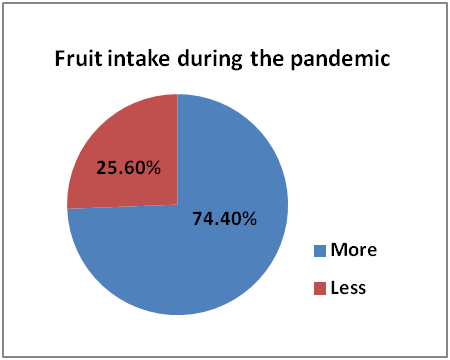 | Figure 6. Fruit intake during the pandemic |
3.4. Health and Hygiene Practices Adopted During the Pandemic
- With the onset of pandemic, various safety measures were introduced such as wearing mask, washing hands and using sanitizer. The existing risk associated with the SARS-CoV-2 infection, has led to improved hygiene practices which have been adopted during the lockdown period. A study conducted in Poland with women has shown improved hygiene practices during the pandemic as women confessed to be using disinfectants, washing hands and use of sanitizers and majority of the surveyed women declared to maintain their new habits even after the end of the pandemic [19]. The survey conducted brought out information on how and what women felt about wearing the masks, if they believe that it can reduce the risk of infection and if it had any adverse health effects on then. 66.2% women believed that wearing mask can actually reduce the risk of infection; however 53.4% reported that they were not comfortable wearing masks. 62% participants used cloth masks while 17.6% reported to use surgical mask. Women were found typically aware of hygiene and 54.8% using cloth mask reported that they washed and sterilized it daily. It was also found that there were no major health issues observed due to the usage of masks, as 56.3% women reported to experience no side effects related to masks, however 25.6% women reported breathing issues and skin rashes and itching and ear pain were some other symptoms reported (Figure. 7). However, 53% of the participants were not very comfortable while wearing mask (Figure. 8). On an average Rs. 500-1000 was allocated to be spent monthly on the purchase of preventive measures (n=150) (Figure. 9). The survey only included those who attempted and submitted the questionnaire. Those who saw and chose not to participate could not be determined. However it may be said that those women who were interested in physical activity and their health and hygiene took part in the online survey. However, previous studies have suggested that the quality of responses may be reduced in online surveys [20]. Since the results of these surveys are direct, the results should be carefully interpreted considering all the limitations. The majority of the respondents were from India and we could not capture a more diverse population.
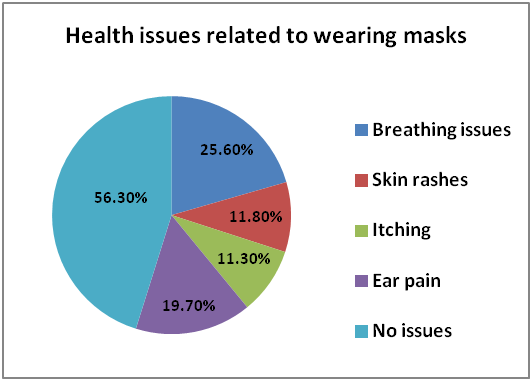 | Figure 7. Health issues related to masks |
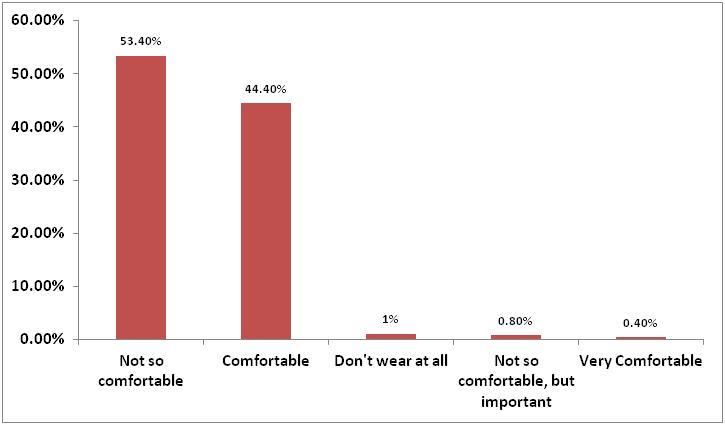 | Figure 8. Inclination/Preferability towards wearing masks |
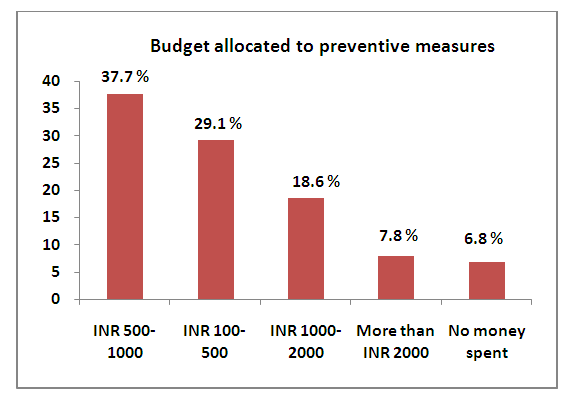 | Figure 9. Budget allocated on preventive measures |
4. Conclusions
- Although the coronavirus led COVID-19 pandemic is having potentially catastrophic impacts on the health of women and girls around the world, this online survey brought out many enlightening facts about women especially youth. Although the literature survey and several current studies suggest that effects of the pandemic are discriminating with the women of the society suffering more in terms of excess work load at home, monitory and professional loss, yet, the conducted survey revealed that they became more concerned for their health and well-being at the same time. Despite of a number of issues faced by them, the isolation period also gave them a chance to spend time with their family and for self care. Physical and fitness activities at home were adopted by a majority of women to be hale and hearty during the pandemic. A fair number of women believed that masks do help in reducing the risk of contracting the virus. The awareness may be due to their sound educational background as the majority of women had university level education. They became more sound about health and nutrition and got much needed time to explore themselves and work on things that interests them the most, which reflects the positive side of the pandemic.
ACKNOWLEDGEMENTS
- The authors are thankful to Dr. (Mrs.) V. Prakash, Principal, Isabella Thoburn College, and Head, Department of Chemistry, Integral University, Lucknow for their whole hearted support.
 Abstract
Abstract Reference
Reference Full-Text PDF
Full-Text PDF Full-text HTML
Full-text HTML